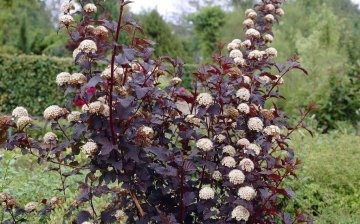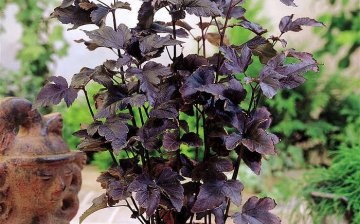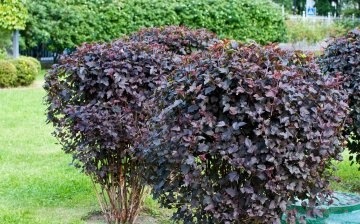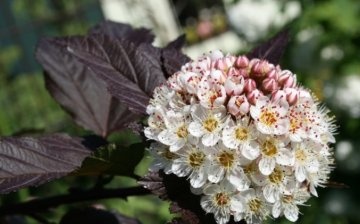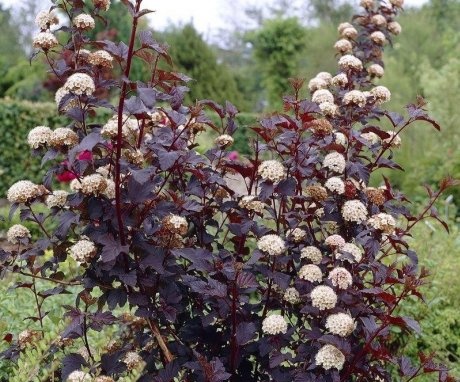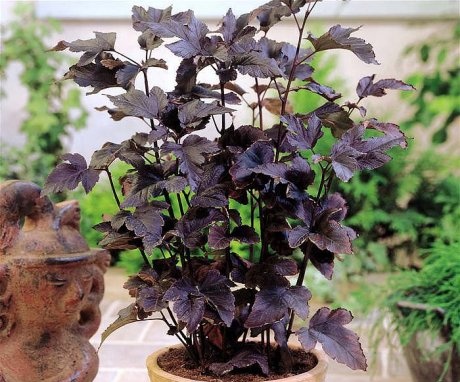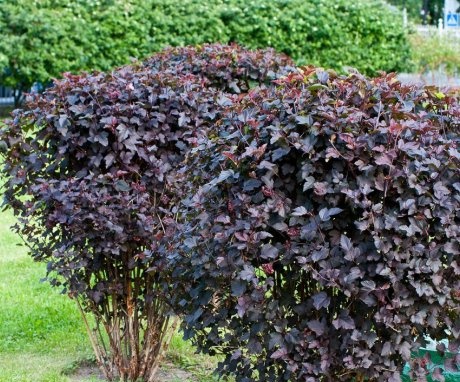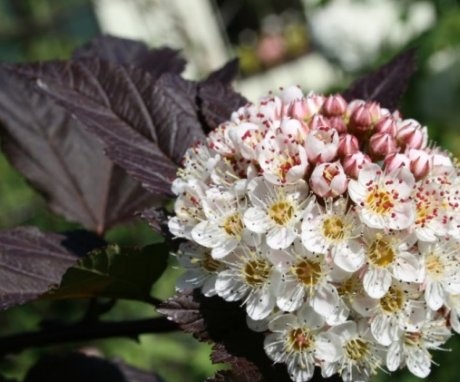How to properly cultivate the Diabolo bubble?
A lot of different types of plants are intended for the decorative design of the site. Among them, certain species stand out, which provide gardeners with an aesthetic appearance and ease of growing. These specimens include the Diabolo bubble.
Content:
- Shrub description
- Reproduction and planting
- Care tips: watering, feeding and pruning
- Diseases and pests
Shrub description
Bubble distributed in East Asia and North America. The growing area covers various climatic conditions. The plant is represented by about 15 species that have characteristic distinctive features. Separately in the genus, decorative species are distinguished, which differ in aesthetic appearance and special properties that manifest themselves in the process of development. This can be the color of the plant, a separate characteristic pattern.
Among ornamental shrubs, the Diabolo bubble plant is especially popular - this is due to the simplicity and showiness of the bush.
In the process of development, the bush reaches sufficient size for decorative tasks. It is quite spreading, and its thin branches gradually bend, creating a dense and beautiful crown. The leaves are up to 6-7 centimeters long and are divided into 3-5 lobes. The color of the foliage is determined by the light and the season. So, growing in a darkened place leads to the formation of green leaves that have a purple hue. In a sunny area, on the contrary - the color even reaches a black hue.
By the way, the peculiarity and attractiveness of the bush, which is determined by unusual shades, is caused by a violation in the process of chlorophyll formation. Due to a natural error and a violation of synthesis, the bush has attractive colors and decorative value. So the disadvantage became the most important advantage. The bark of the shrub has a dark burgundy color, and as the plant matures, it acquires a brown tint. At the beginning of summer, the diabolo bladder blooms, evenly covered with pink flowers. Some gardeners may find the resulting flowers not attractive enough, but they are nevertheless very delicate and fragrant. The flowering process takes 2-3 weeks, and in some cases flowering can take up to 2 months. This duration makes it the most long-flowering shrub.
The name of the shrub is due to the type and shape of the fruits of the plant - they are swollen bubbles, or leaflets.
If you press on them, the bubbles explode with a characteristic click. And this property gave the name to the vesicle. In summer, the leaflets are green. Once they reach maturity, they take on a characteristic reddish brown color. These fruits cover the shrub even more than flowers. These fruits fully ripen in the first weeks of autumn, after which they remain on the bush for a long time.
Also, the decorative value of the vesicle is associated with the duration of development in one place, which can reach 50 years. In other words, once you have planted a shrub on the site, you can get a beautiful plant that decorates the territory for half a century.And yet - the height of the bush reaches 3.5 meters.
Reproduction and planting
The Diabolo bladder shrub can have a closed root placed in a container or an open root. In the first case, it can be planted throughout the growing season. Open root system suitable for planting only in early spring or autumn. For propagation and planting of shrubs, there are several universal rules that are suitable for each specimen.
Features of planting a bush:
- Before planting, it is necessary to place the bladder in water for several hours.
- The landing pit has dimensions in the form of a cube with sides of 60 centimeters.
- Before planting, the soil must be prepared in a special way, for which a certain amount of peat and humus is introduced.
- The root is carefully placed in the prepared hole and covered with soil. In this case, the root collar is sprinkled with earth for a few centimeters.
- This creates optimal conditions for the development of buds, which serve for the development of young branches.
- After covering the young roots with soil, they must be watered abundantly. Watered in several stages. Water seeping into the soil leads to an even distribution of the soil.
- The territory adjacent to the bush mulch using grass and sawdust. Thus, constant air exchange in the soil horizons is maintained, and moisture is also retained for a long time.
- Watering is carried out every 2-3 days until the vesicle shows signs of germination of the first branches. In practice, it has been noticed that the bush grows extremely slowly for the first season after planting, because hot weather significantly limits it.
The bubble plant has small seeds, which can be collected quite a lot from just one leaflet. There is an important feature that limits the reproduction of a plant through seeds - parent plants do not always transfer their external characteristics, such as the color of leaves, to their "children". Therefore, it is recommended to wait for the germination of the bush, after which those specimens that have an atypical color are simply discarded.
Gardeners prefer to grow shrubs using cuttings.
This technique allows you to create new plants with the desired and expected characteristics. At the end of summer, it is worth cutting off a few young branches that have several buds. They must be cut at an acute angle, and they do it in the morning or in cold weather - this contributes to the stability of the cuttings and resistance to wilting. The leaves are simply removed from the bottom. Also, in some cases, half of the upper leaves are cut off.
After these preparatory stages, the cutting is treated with heteroauxin or aloe juice. Sometimes additional enhancers are used to stimulate the growth of the root system. To germinate new roots, you need to place them in a dark place and cover with foil. The shrub should overwinter under an artificial shelter. And in the spring, the bush is transplanted to the place of future growth, having previously saturated the soil with peat and sand.
Care tips: watering, feeding and pruning
An important feature for which gardeners love and appreciate the Diabolo vesicle is associated with the ease of caring for the shrub. It is easy to plant, and if handled correctly, you get a beautiful plant that becomes a decoration of the site. The shrub grows on various types of soils, but is especially active on loams with an acidic environment. At the same time, on rich drained soils, it feels very good.
Resistance to gas pollution and negative environmental factors attracts attention for decorating urban areas. The only point that should be avoided is stagnation of water in the area of the root system. Pruning any bush is a must and very important exercise. And for ornamental plants, this process is especially important.In order to harmoniously integrate the shrub into the created landscape, it is often necessary to change its shape, which is done with the help of special cutting.
The diabolo bladder shrub tolerates pruning especially well, which is important for an ornamental plant.
The grower can easily form the necessary crown. The first pruning, which forms the crown of the bush, is performed in the first year of the life of the bush. Using a simple pruning shear or a garden knife, the top of the branch is cut off, which stimulates the development of lateral shoots. In the summer, such pruning is performed several times.
In the process of shrub growth, the bush can be given various forms. If you neglect pruning and leave the growth of the bush without attention and adjustment, then the bush will quickly grow old and lose its appearance.
Diseases and pests
The diabolo bubble is very resistant to various diseases... It successfully resists attacks of various insects and pests... With minimal nutrition and support from the gardener, the bush is characterized by stable growth and confident development, which helps its distribution for various decorative tasks.
Bubble shrub Diabolo is used to create decorative fences and a variety of landscape compositions.
For the creation of horticultural objects and landscape design, this bush is used, which can be easily trimmed to one height to create a unique beauty of the elements.
To form new landscapes, complex planting of plants is used, in which small bushes are planted next to the vesicle, such as hydrangea... The main area of application of the shrub is landscape design and decoration of various objects, from a personal plot to large city streets.
More information can be found in the video:




